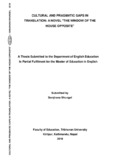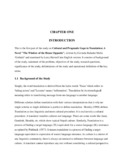Please use this identifier to cite or link to this item:
https://elibrary.tucl.edu.np/handle/123456789/1745| Title: | Cultural and Pragmatic Gaps in Translation: A Novel "The Window of the House Opposite" |
| Authors: | Dhungel, Samjhana |
| Keywords: | Translation;English Education |
| Issue Date: | 2018 |
| Publisher: | Central Department of Education English |
| Abstract: | This research entitled Cultural and Pragmatic Gaps in Translation: A Novel "The Window of the House Opposite" was conducted to find out gaps of cultural and pragmatic expressions used in the novel 'Pallo Gharko Jhyal' and its English version 'The Window of the House Opposite'. To carry out this research study, thirty cultural and thirty pragmatic expressions were selected by using non-random judgmental sampling procedure. Selected data were analyzed and interpreted using analytic description as well as intensive study of both versions of the novel. Similarly, selected data were categorized into degree of meaning conveyed equivalence and meaning gap or maintained. Eight cultural and eight pragmatic expressions were optimally translated. Likewise, five cultural expressions and seven pragmatic expressions were found to be near optimally translated. Similarly, six cultural and seven pragmatic expressions were partially translated. In the same way, four cultural and five pragmatic expressions were found stronger and weaker versions of translation. Likewise, five cultural and two pragmatic expressions were mistranslated. In a similar way, one cultural and one pragmatic expression were categorized under poor translation. Finally, one cultural expression fell under zero equivalence translation. This thesis study is divided in to five chapters. The first chapter deals with the background of the study, statement of the problem, objectives of the study, research questions, significance of the study, delimitations of the study and operational definitions of key terms. The second chapter includes review of related theoretical literature, empirical literature, implications of the study and conceptual framework. Chapter three contains design of the study, population, sample and sampling strategy, research tools, sources of data, data collection procedure, data analysis procedure and ethical considerations. Similarly, chapter four discusses the analysis of data and interpretation of results. Finally, chapter five presents main findings, conclusion, and recommendations. References and appendices are the concluding part of the study. |
| URI: | http://elibrary.tucl.edu.np/handle/123456789/1745 |
| Appears in Collections: | English Language Education |
Files in This Item:
| File | Description | Size | Format | |
|---|---|---|---|---|
| Cover Page(5).pdf | 33.59 kB | Adobe PDF |  View/Open | |
| CHAPTER ONE-3.pdf | 2.77 MB | Adobe PDF |  View/Open |
Items in DSpace are protected by copyright, with all rights reserved, unless otherwise indicated.
